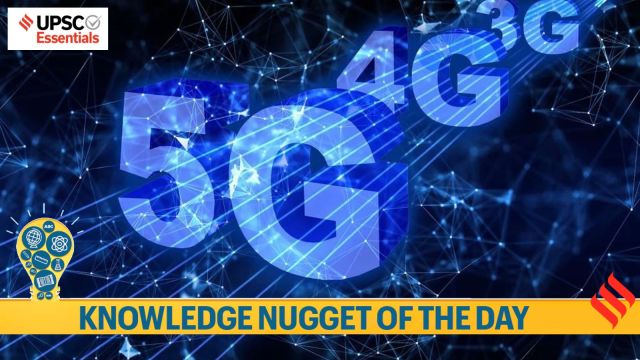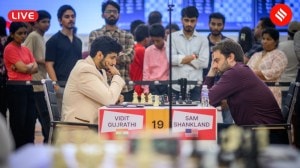
 During his address, PM Modi commissioned more than 97,500 BSNL 4G mobile towers built with indigenous technology at a cost of ₹37,000 crore, under Digital Bharat Nidhi. (Source: Photo by PTI)
During his address, PM Modi commissioned more than 97,500 BSNL 4G mobile towers built with indigenous technology at a cost of ₹37,000 crore, under Digital Bharat Nidhi. (Source: Photo by PTI)
Key Takeaways :
1. Launched in the late 1970s in Japan, 1G was the first generation of mobile telecommunication technology that offered voice calls only. But it came with low sound quality, low coverage, and without any roaming support.
Story continues below this ad
2. The major leap for telecom tech of that time came in 1991 with the introduction of 2G. The analog signals of 1G became completely digital in the second generation.
3. Apart from introducing the CDMA (Code Division Multiple Access) and GSM (Global System for Mobile Communication) concepts, it allowed users to roam and offered small data services like SMS and MMS at a maximum speed of around 50 kbps. While the focus was still on voice calling, data support was introduced.
4. Mobile technology kept its date with generational leap every decade with the introduction of 3G services in 2001. It promised four times faster data transmission with access to mobile Internet. This is the generation that brought emails, navigational maps, video calling, web browsing and music to mobile phones
5. High speed, high quality, high capacity voice and data services – that’s the promise that 4G brought with it around 2010. Standard 4G came with five to seven times faster speeds than 3G.
Story continues below this ad
6. Compared to 3G, a phone on a 4G network got quicker response to its requests (lower latency). This is what made our phones more like hand-held computing devices.
7. 5G or fifth generation brought major upgrades in the long-term evolution (LTE) mobile broadband networks. 5G mainly works in 3 bands, namely low, mid and high frequency spectrum — all of which have their own uses as well as limitations.
8. With increase in cellular bandwidth, blazing speed and low latency, 5G boosts the ‘Internet of Things’ by making it easy for several devices to connect to each other to communicate and to be controlled remotely.
9. From generation one (1G) to the fifth, each generation of telecom technology has sought to change for the better the way humans interact with each other and the world around them. Notably, while technically not a functioning technology as of now, 6G has been conceived as a far superior technology promising internet speeds up to 100 times faster than 5G.
Story continues below this ad
BEYOND THE NUGGET: Bharat 6G Project
1. India is gearing up to roll out high-speed 6G communication services by 2030 and has set up a Bharat 6G project to identify and fund research and deployment of the next-generation technology in the country, according to a vision document unveiled by Prime Minister Narendra Modi in October last year.
2. India’s 6G project will be implemented in two phases, and the government has also appointed an apex council to oversee the project and focus on issues such as standardisation, identification of the spectrum for 6G usage, create an ecosystem for devices and systems, and figure out finances for research and development, among other things.
3. While, technically, 6G does not exist today, it has been conceived as a far superior technology promising internet speeds up to 100 times faster than 5G.
4. As per the vision document, 6G use cases will include remote-controlled factories, constantly communicating self-driven cars and smart wearables taking inputs directly from human senses. However, while 6G promises growth, it will simultaneously have to be balanced with sustainability since most 6G supporting communication devices will be battery-powered and can have a significant carbon footprint, the document said.
Story continues below this ad
5. The 6G project is proposed to be implemented in two phases: the first one from 2023 to 2025 and the second one from 2025 to 2030.
(i) In phase one, support will be provided to explorative ideas, risky pathways and proof-of-concept tests.
(ii) Ideas and concepts that show promise and potential for acceptance by the global peer community will be adequately supported to develop them to completion, establish their use cases and benefits, and create implementational IPs and testbeds leading to commercialisation as part of phase two.
6. Prime Minister Narendra Modi formally launched 5G services in October 2022 and said at the time that India should be ready to launch 6G services in the next 10 years. As opposed to 5G, which at its peak can offer internet speeds up to 10 Gbps, 6G promises to offer ultra-low latency with speeds up to 1 Tbps.
Post Read Question
Consider the following statements:
Story continues below this ad
1. India is gearing up to roll out high-speed 6G communication services by 2030.
2. 5G services were formally launched in October 2022 in India.
3. The government has set up a Bharat 6G project to identify and fund research and deployment of the next-generation technology in the country.
How many of the statements given above is /are correct?
(a) Only one
(b) Only two
(c) All three
(d) None
(Sources: 1G to 5G and further: What changes with each ‘G’?, PM launches BSNL’s ‘swadeshi’ 4G network, Bharat 6G project: India plans to roll out high-speed internet by 2030)
Story continues below this ad
Subscribe to our UPSC newsletter. Stay updated with the latest UPSC articles by joining our Telegram channel – Indian Express UPSC Hub, and follow us on Instagram and X.
🚨 Anniversary Special: Read the UPSC Essentials September 2025 special edition, celebrating two years of the magazine! Share your views and suggestions at manas.srivastava@indianexpress.com 🚨



 During his address, PM Modi commissioned more than 97,500 BSNL 4G mobile towers built with indigenous technology at a cost of ₹37,000 crore, under Digital Bharat Nidhi. (Source: Photo by PTI)
During his address, PM Modi commissioned more than 97,500 BSNL 4G mobile towers built with indigenous technology at a cost of ₹37,000 crore, under Digital Bharat Nidhi. (Source: Photo by PTI)






























